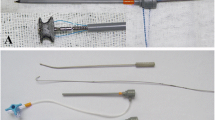Abstract
The majority of ventricular septal defects (VSDs) are perimembranous, accounting for 75–80% of all VSDs. The objective of this study was to investigate occluder selection and transcatheter closure technique for multi-hole perimembranous VSD with aneurysm, and to evaluate clinical efficacy and safety. Patients with multi-hole VSDs and aneurysm (n = 64) were selected for the procedure using transthoracic echocardiography. Double-disc symmetrical, small-waist double-disc asymmetrical and zero eccentricity occluders were selected based on left ventricular angiography. The closure was successful in 63 of 64 patients (98%). The double-disc symmetrical occluder was used in 16 cases, the small-waist double-disc asymmetrical occluder in 42 cases, and the zero eccentricity occluder in 8 cases (2 occluder types were used in 2 cases). Fifteen minutes after the procedure, 52 cases had no residual shunt and 12 had a trace amount of residual shunt. The residual shunt disappeared in five cases 5–7 days post procedure, with a trace amount of shunt remaining in seven cases. Transient conduction abnormalities related to the procedure occurred in six patients; however, none required permanent pacemaker implantation. At the 1-month, 6-month, 1-year, 2-year, and 3-year follow-up visits, echocardiography indicated that the position of the occluders was fixed, and there were no complications including residual shunt, newly developed atrioventricular block, thromboembolism, or bacterial endocarditis. The study results indicate that left ventricular angiography is useful in selecting the most appropriate device for transcatheter closure of multi-hole perimembranous VSD with aneurysm. The transcatheter closure procedure is safe and effective with little residual shunt and no major complications for up to 3 years of follow-up.



Similar content being viewed by others
References
Andersen HO, de Leval MR, Tsang VT, Elliott MJ, Anderson RH, Cook AC (2006) Is complete heart block after surgical closure of VSDs still an issue? Ann Thorac Surg 82:948–956
Anil SR, Sreekanth R, Bhalerao S, Nagarajan R, Agarwal R, Girish NB (2005) Transcatheter closure of perimembranous ventricular septal defect with amplatzer membranous occluder. Indian Heart J 57:698–703
Bass JL, Kalra GS, Arora R, Masura J, Gavora P, Thanopoulos BD, Torres W, Sievert H, Carminati M, Fischer G, Ewert P (2003) Initial human experience with the Amplatzer perimembranous ventricular septal occluder device. Catheter Cardiovasc Interv 58:238–245
Carminati M, Butera G, Chessa M, De Giovanni J, Fisher G, Gewillig M, Peuster M, Piechaud JF, Santoro G, Sievert H, Spadoni I, Walsh K, Investigators of the European VSD Registry (2007) Transcatheter closure of congenital ventricular septal defects: results of the European Registry. Eur Heart J 28:2361–2368
Gu XP, Han YM, Titus JL, Amin Z, Berry JM, Kong H, Rickers C, Urness M, Bass JL (2000) Transcatheter closure of membranous VSDs with a new nitinol prosthesis in a natural swine model. Catheter Cardiovasc Interv 50:502–509
Hijazi ZM, Hakim F, Haweleh AA, Madani A, Tarawna W, Hiari A, Cao QL (2002) Catheter closure of perimembranous VSDs using the new Amplatzer membranous VSD occluder: initial clinical experience. Catheter Cardiovasc Interv 56:508–515
Hirsch R, Lorber A, Shapira Y, Brosh D, Khoury A, Bass JL, Kornowski R, Battler A (2007) Initial experience with the Amplatzer membranous septal occluder in adults. Acute Card Care 9:54–59
Ho SY, McCarthy KP, Rigby ML (2004) Morphology of perimembranous ventricular septal defects: implications for transcatheter device closure. J Interv Cardiol 17:99–108
Holzer R, de Giovanni J, Walsh KP, Tometzki A, Goh T, Hakim F, Zabal C, de Lezo JS, Cao QL, Hijazi ZM (2006) Transcatheter closure of perimembranous ventricular septal defects using the amplatzer membranous VSD occluder: immediate and midterm results of an international registry. Catheter Cardiovasc Interv 68:620–628
Jian-Jun G, Xue-Gong S, Ru-Yuan Z, Min L, Sheng-Lin G, Shi-Bing Z, Qing-Yun G (2006) Ventricular septal defect closure in right coronary cusp prolapse and aortic regurgitation complicating VSD in the outlet septum: which treatment is most appropriate? Heart Lung Circ 15:168–171
Masura J, Gao W, Gavora P, Sun K, Zhou AQ, Jiang S, Ting-Liang L, Wang Y (2005) Percutaneous closure of perimembranous ventricular septal defects with the eccentric Amplatzer device: multicenter follow-up study. Pediatr Cardiol 26:216–219
Qin Y, Chen J, Zhao X, Liao D, Mu R, Wang S, Wu H, Guo H (2008) Transcatheter closure of perimembranous ventricular septal defect using a modified double-disk occluder. Am J Cardiol 101:1781–1786
Qin YW, Zhao XX, Li WP, Zheng X, Ding JJ, Xu RL, Cao J, Mao HJ (2002) Transcatheter closure of perimembranous VSDs using homemade two-disk device. J Interv Radiol 11:130
Qin YW, Zhao XX, Wu H, Zheng X, Ding JJ, Xu RL, Cao J (2005) The safety and efficacy of transcatheter closure of homemade nitinol occluder for perimembranous VSDs. Chin Circ J 20:10
Qin YW, Zhao XX, Wu H, Wang ES, Zheng X, Ding JJ, Cao J (2004) The transcatheter closure of intracristal and subpulmonary VSD. J Interv Radiol 13:486–489
Yilmaz AT, Ozal E, Arslan M, Tatar H, Oztürk OY (1997) Aneurysm of the membranous septum in adult patients with perimembranous ventricular septal defect. Eur J Cardiothorac Surg 11:307–311
Acknowledgment
Funded by Shanghai scientific and technological projects, subject code: 014119003.
Author information
Authors and Affiliations
Corresponding author
Rights and permissions
About this article
Cite this article
Wu, H., Qin, Y., Zhao, X. et al. Transcatheter closure of multi-hole perimembranous VSD with aneurysm: 3-year follow-up study. Clin Res Cardiol 98, 563–569 (2009). https://doi.org/10.1007/s00392-009-0044-y
Received:
Accepted:
Published:
Issue Date:
DOI: https://doi.org/10.1007/s00392-009-0044-y




